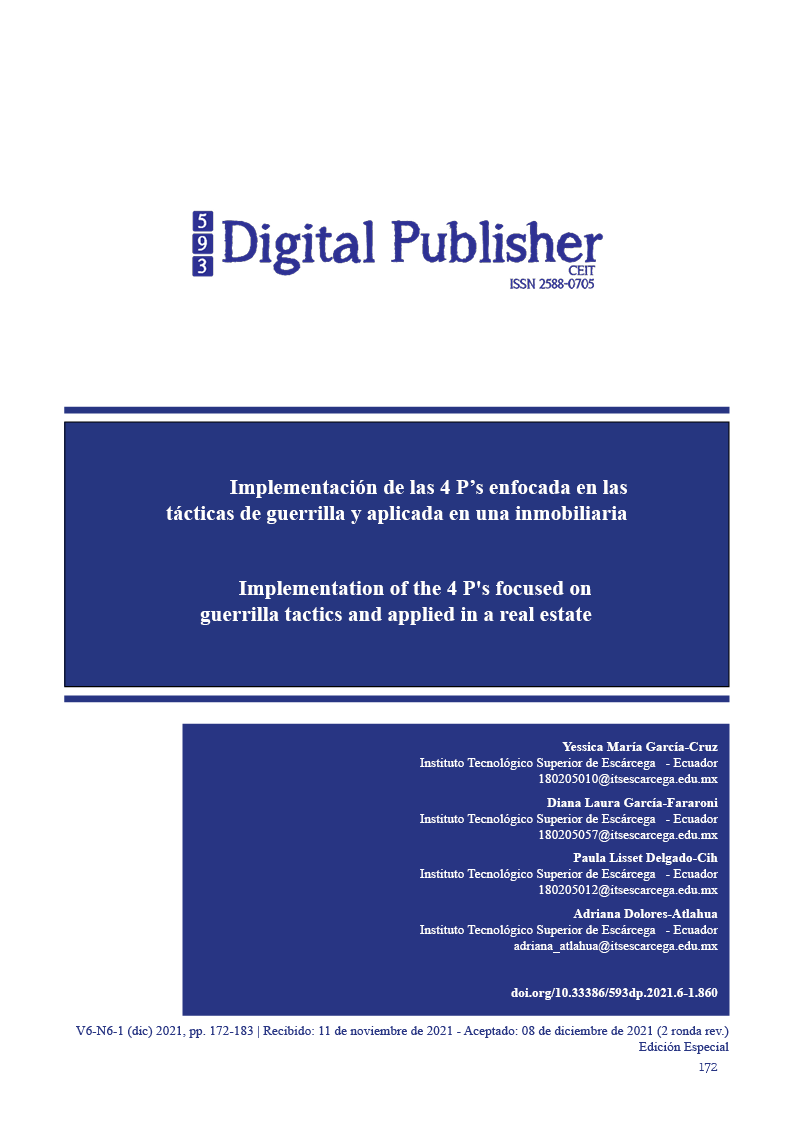Implementation of the 4 P's focused on guerrilla tactics and applied in a real estate.
Main Article Content
Abstract
Over time, real estate companies have sought to stay ahead of the demand from customers and especially from competitors; who in turn are aimed at continuous improvement, offering a variety of unique and highly effective services to meet the needs of purchasers. That is why, the purpose of this research is to establish and apply strategies using Guerrilla marketing tactics and focused on the 4 P's of marketing for MSMEs that allow the increase in the number of clients and recognition in a real estate agency in the Municipality of Escárcega, Campeche. The research is framed in the qualitative approach, using the single case study method, in which, it is intended to collect data through surveys with closed questions to 241 people who are mainly between 40 to 74 years old and who are economically active with middle income. Upon having collected such information, the data will be analyzed using statistics and inferentials that allow its interpretation. This will help create strategies that reduce the lack of advertising, improve your location and physical image, make it easier for the customer to make the purchase decision, as well as the establishment of a fair and competent price.
Downloads
Article Details

This work is licensed under a Creative Commons Attribution-NonCommercial-ShareAlike 4.0 International License.
1. Derechos de autor
Las obras que se publican en 593 Digital Publisher CEIT están sujetas a los siguientes términos:
1.1. 593 Digital Publisher CEIT, conserva los derechos patrimoniales (copyright) de las obras publicadas, favorece y permite la reutilización de las mismas bajo la licencia Licencia Creative Commons 4.0 de Reconocimiento-NoComercial-CompartirIgual 4.0, por lo cual se pueden copiar, usar, difundir, transmitir y exponer públicamente, siempre que:
1.1.a. Se cite la autoría y fuente original de su publicación (revista, editorial, URL).
1.1.b. No se usen para fines comerciales u onerosos.
1.1.c. Se mencione la existencia y especificaciones de esta licencia de uso.
References
Agudelo, M., & Saavedra, B. (2013). El CRM como herramienta para el servicio al cliente en la organización. Visión de Futuro, 17.
Arce Burgoa, L. G. (2010). Como lograr definir objetivos y estrategias comerciales. Universidad y Sociedad, 406.
Arellano, R. (2000). Marketing, enfoque América Latina. México: Mc Graw Gill.
Aytekin, P., & Nardali, S. (2014). Guerrila marketing communication tools and ethical problems in guerrila advertising. . American Journal of Economics and Business Administration.
Bose, R., & Sugumaran, V. (2002). “Application of Knowledge Management technology in Customer Relationship Management”. . Knowledge and Process Management.
Correa, J. (2012). Metodología dela investigación. Repositorio UTM.
Díaz, C. (2019). ¿Qué es la mezcla de mercadotecnia? ¿Qué es la mezcla de mercadotecnia? Universidad de Guadalajara, Sistema de Universidad Virtual., Guadalajara Jalisco, México.
Fisher de la Vega, L. E., & Espejo Callado, J. (2011). Mercadotecnia. México D.F: Mc Graw Gill.
Fisher, L., & Espejo, J. (2011). Mercadotecnia. México D.F: Mc Graw Gill.
Fisher, L., & Espejo, J. (2011). Mercadotecnia. México D.F: Mc Graw Gill.
González, J. C. (2014). Estrategias de Marketing Digital para la agencia inmobiliaria JQ Bienes Raíces. Estrategias de Marketing Digital para la agencia inmobiliaria JQ Bienes Raíces. Escatep, México D.F.
Gupta, A. K., & Govindarajan. (1984). Business unit strategy, managerial characteristics and business unit effectiveness at strategy implementation. Academy of Management Journal, 41.
Hernández, J. D., & Dominguez, M. L. (2003). Estrategias de mercadotecnia y los negocios de mezcal. Convergencia, 10, 31, 187-204.
Hernández, R., Fernández, C., & Baptista, M. (2010). Metodología de la Investigación. México.
Kotler, P. (2005). Las preguntas más frecuentes sobre Marketing. Bogotá, Colombia.: Norma.
Kotler, P. (2008). Introducción al Marketing. México: Prentice Hall.
Kotler, P., & Armstrong, G. (2001). Fundamentos de Marketing . México: Pearson.
Kotler, P., & Armstrong, G. (2003). Fundamentos de Marketing. México.
Krieger, K. H. (2012). Guerrilla Marketing. Springer- Verlag.
Martínez, M. (2014). 2014. Plan de Marketing digital para PYME. Facultad de Ciencias Empresariales, Santiago de Cali.
Nordberg, M., Campbell, A., & Verbeke, A. (2003). Using customer relationships to acquire technological innovation. A value-chain analysis of supplier contracts with scientific research institutions,. Journal of Business Research, 719.
Rafiq , M., & Ahmed, P. K. (1995). Using the 7Ps as a generic marketing mix: an exploratory survey of UK and European marketing academics. The 7Ps framework has clear advantages over the 4Ps framework. Marketing inteligence y Planning.
Sheppeck, M., & Militello, J. (2000). Strategic HR configurations and organizacional performance. Human Resource Managment, 39.
Stanton, W. J., Etzel, M. J., & Walker, B. J. (2007). Fundamentos de Marketing. México D.F: Mc Graw Hill.
Valls, J., Guitart, L., & Núñez, A. (2007). La innovación en la empresa, el concepto y su medida. Revista de Contabilidad y dirección.
Widlund, P. (2003). “CRM y e-CRM: vender más y mejor”. Marketing + Ventas.
Yin, R. (1994). Case Study Research: Design and Methods. . Sage Publications, Thousand.
Zarella, D. (2011). Marketing con Facebook. Madrid: Grupo Anaya.
Zineldin, M., & Philipson, S. (2007). Kotler and Borden are not dead: myth of relationship marketing and truth of the 4Ps. . Journal of consumer marketing.





